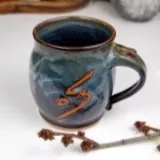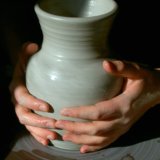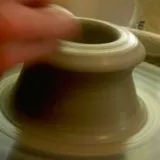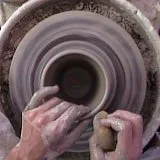Making Pottery
Answers to Frequently Asked Questions
How to... buy, build, do, glaze, paint, fire, throw or learn about making pottery. Find answers about throwing pottery, pottery clay, glazing and painting clay pots. Read equipment reviews, buy ceramic supplies, free online pottery wheel lessons.
Think of this as your online how to pottery book, video and free personal pottery teacher. Learn about making pottery with a wheel, whether at home, in a studio, with kids or adults. Also learn how to make clay, buy pottery equipment, pottery glazes, and much more.
This is a new addition to the site and will have more answers added regularly. If you don't see what you are looking for, use the Pottery Site Search to quickly and easily find any keyword or phrase.
FAQ's
General Pottery Questions
Why is it called pottery wheel "throwing" or "throwing" clay? - Some say it is called throwing because many potters, when making pottery, actually throw the clay onto the wheel to make it stick.
Others argue that it is called wheel throwing because the origins of the phrase "to throw" means "to turn" or "to twist", like the turning of the pottery wheel.
I think it's because when you mess up a pot that you've been working on all day, you want to throw the clay out the window.
Firing Pottery Questions
What is a pyrometric cone?- Pyrometric cones are specially formulated cones of clay material designed to melt after they have experienced a certain amount of "heat work". They range in temperature from lowest 022 to highest 10.
What is High Fire Pottery? - High fire pottery is made of clay and glazes that work best when fired in the kiln between about cone 6 and cone 10. This heat range generally makes pottery strong, less porous, and more durable for functional pottery such as dinnerware. Much of the high functional food use pottery for sale by potters is high fire.
What is Low Fire Pottery? - Low fire pottery clay usually fires between cone 05 and about cone 2. Lowfire or earthenware pottery is created by adding frits and fluxes to the clay to make it melt at a lower temperature.
The benefits of earthenware pottery are two things:
1) Lower firing temperatures means it is easier, quicker, and less expensive to fire the pottery kiln. This gives more people access to making pottery.
2) It also makes some colors easier to achieve in glazes. The high temperatures of high fire glazes tends to cook the brightness out of them. While bright reds, oranges and yellows are not impossible in high fire kilns, they are much easier in low fire kilns.
There are also drawbacks:
1) Low fire tends to be more porous making it less water tight for use with dinnerware.
2) Earthenware is also less durable due to the added minerals required to melt it at lower temperatures and therefore more prone to chipping or breaking. (Keep in mind these are generalizations and there are always exceptions).
What is Earthenware? - Earthenware is basically another name for low fire pottery (see discussion above).
Pottery Glaze Questions
What is glaze? - Glaze is a mixture of minerals suspended in water. When pottery is coated in glaze and fired, the glaze fuses into a glass-like surface, adding decoration and durability to the pottery.
How Do I Make My Own Pottery Glazes? - Making customized pottery glazes is the subject of years of study for many potters. Each glaze recipe is formulated then tested color, quality, firing temperature, and "fit" with any chosen clay body.
In a nutshell, glazes recipes are formulated by combining different amounts of glaze minerals, mixing them with water, applying them to the surface of a pot, and then firing them to see what happens.
You can buy glaze books with tried and true recipes. You can also buy premixed glaze recipes wherever you purchase ceramic supplies and modify them by combining them or adding minerals to them. Finally, you can formulate your own glazes by experimenting with different glaze ingredients (also available at many ceramic supply stores) to formulate your own.
How Are Pottery Glazes Applied to the Pot? - The most common ways pottery glazes are applied to pots is by spraying the pottery, dipping it, pouring glaze over the pot, or painting the glaze onto the pot in 2-4 layers.
Pottery Clay Questions
What is clay? - Clay is a naturally occurring collection of minerals with fine particle size. Clay naturally holds water, hardens when dried and fired, and holds it's shape well when formed and stretched. This stretchability is known as plasticity.
With practice you can learn how to throw pottery clay into functional projects and then fire them to make them permanent.
What is a Clay Body? - A clay body refers to the makeup of the clay based on it's individual ingredients. Different projects require different clay bodies and therefore different amounts and types of ingredients.
The ingredients of the clay body determine whether the color is white, buff, brown, red, or a brightly stained color. They also determine the firing temperature, and what can be created with the clay.
Some have more grog (a sand-like clay material) that adds strength and reduces shrinkage. Others have more of one type of clay, such as Kaolin, stoneware, or Ball Clay. Still others have fluxes that cause them to melt (or vitrify) at lower kiln firing temperature. For example, if you are making quality pottery dinnerware you would probably use a smooth clay body with a low grog content and a higher firing clay for durability and water tightness.
What is wedging? - Wedging is the process of kneading pottery clay to remove air bubbles, mix it to consistency, and align the clay particles to aid in wheel throwing.
There are two main types of wedging: spiral kneading and table wedging.
What is spiral kneading? - Spiral kneading mixes and removes the air from clay by stretching and pressing it into a table. As the clay is rotated it takes on a spiral shape.
What is table wedging? - Table wedging involves pounding the clay on the table, then cutting it in half, flipping it over, and pounding it back together again until it is smooth and bubble free.
What is porcelain pottery clay? - Porcelain clay is usually a white high fire clay high in Kaolin. It often is fired to cone 9 or 10 in the glaze kiln. Porcelain is excellent for delicate sculpture, dinnerware, tea pots and sets, and tile. When thrown thin enough it has a translucent quality like a sea shell. It takes on an ethereal glow in the right light. It is generally less "plastic" or stretchy than other functional clays and is therefore used less often for large pots such as floor vases.
What is pottery stoneware clay? - Stoneware is an sturdy, opaque clay excellent for functional potters making pottery projects such as dinnerware, cookware and bakeware, mugs, plates and bowls. It is also a high fire pottery clay making it well vitrified and less porous than most clays. This and it's durability make it great for use with food and dinnerware with the right ceramics glaze.
How can I reconstitute old, dry clay? - This is a common question and a good one. First begin by breaking it up into small pieces. Next, place it in a bucket and add water until it just covers the clay. Let it soak for a few days while the clay softens.
Once it has softened, you can then use a mixer attached to a power drill, or even just a heavy stick... anything to stir the clay with. Stir the slurry mixture until it is well mixed. It shouldn't be too runny... like pancake batter is a good consistency. If it is too runny, you may need to add some more clay to thicken it and then let it soak some more.
Finally, pour your "batter" onto a plaster bat, or into a pillow case or other fabric like the leg of pair of jeans. The reason for the plaster or fabric is that it will absorb and wick the moisture away from the clay more quickly. It will need to dry like this for about a day to several days.
Check it periodically. When it gets close to a more doughy consistency, it is time to wedge it thoroughly. Once you have wedged it thoroughly, it is ready to throw on the pottery wheel. Wedge it well and put it back in the bag to store until you're ready to use it. You can literally store pottery clay for years. In fact, it often gets better with age.
TIP: You want to error on the moist side when you start to wedge the clay because the wedging process will actually cause it to dry out a little more. You can always let it dry longer if it's too wet, but it's tough to add water back in.
Also, if your clay gets just a little dry while in storage, you can wrap a wet dish towel around the lump of clay and put it back in the back. Wait a few days or a week and you will have softer clay. Just be sure to rotate the bag so the water doesn't pool in the bottom and wedge it thoroughly before throwing on the pottery wheel.
Recommended Books
For All of Your Pottery Questions

250 Tips, Techniques, and Trade Secrets for Potters

The Complete Potter

Simon Leach's Pottery Handbook

The Potter's Bible
Questions Other Visitors Have Asked
Click below to see contributions from other visitors to this page...
What weight of clay should be used to throw various size bowls: 10" bowl, 9" bowl, 7" bowl; assuming the height is all about 5"? 




Question: I have been asked to make a set of nesting bowls. I would like some idea of how much clay is needed when trowing various size bowls.
Answer: …
Brent Splash Pan 




Question:
Hi Steve,
I have an older Brent wheel and just purchased a new splash pan for it. The splash pan is very unstable and rubs on the bottom …
How much sodium silicate do I add to colored slip to create the crackle effect on a thrown pot? 




Question: I've been studying Hsin-Chuen Lin's videos and am intrigued with the slip he uses containing sodium silicate.
I know I can brush the sodium …
CAN A PIECE BE REUSED TO MAKE INTO CLAY ONCE IT HAS BEEN FIRED? 




Question: Once a piece has been made and fired is it possible to crush and make into clay again to remake if you don't like?
Answer: Unfortunately, …
Can I Fix My Thrown Pot that's Too Dry to Trim? 




Hi Steve, I like your site it is very helpful.
Question: So, if I have a piece that has become too dry to trim what would be the best way to bring …
Question on Storage Shelves for Wet and Dry Pottery 




(see Steve's reply below)
Hi Steve,
I don't make pottery, but my friend does and he has a studio in his home. He is always throwing plastic covers …
Help! I am trying to create clay monoprints and vessels! 




I am getting ready to start my student teaching next week and thought that I could have students create a clay monoprint (of course inspired by Mitch Lyons) …
Clay Storage 




Question: What is the ideal temperate and humidity to store clay?
Also, are the bags that the clay comes in okay for storage? (in other words, is …
Can you attach real sea shells on ceramic pottery then fire it? 




Question: I want to make a vase with real sea shells on it from the beach. Is it possible to attach them then fire them in the kin for bisque firing …
Can Acrylic Paint Be Fired in a Kiln? 




Question: Can acrylic paint be fired in a kiln?
I have a relief sculpture that is about 3 cm thick, by 10 by 10cm. I'm worried about the acrylic paints …
20 years old greenware; will it fire properly? 




Question:
20 years ago I made a navity, except for three pieces. I recently decided it was time to complete it. Pieces are in excellent condition. …
14 Year-old Interested in Pottery 




Question:
I have a 14 year old granddaughter that expressed interest in pottery. I have been unable to locate classes locally, which I thought might …
my junior cone (sitter cone) bends but the senior cone doesn't. What should I do differently? I have them at the same level in my two tier Skutt Kiln Not rated yet
Question:
My junior cone (sitter cone) bends shutting off my kiln after 7 hours at 05 cone but the senior cone doesn't bend and is at the same level as …
What causes pinholes on my glazed bowl? I used Amaco glaze ironstone, fired to cone 5 in the sitter, cone 6 barely bent, so i didnt overfire. Not rated yet
Question:
Pinholes! All my extruded vases cracked in glaze fire in the valleys of the die.
Answer:
Gosh that's a tough one to answer. Could be a …
Once I've thrown my pot does it need to be fired within a certain time? Not rated yet
Question:
I'm considering getting a wheel but purchasing a kiln at the same time is too expensive. This does give me time to practice throwing. If I …
what would make handles crack on mugs as they dry Not rated yet
Question:
lately I am having problems with my handles cracking as they dry. it is stoneware clay. My clay was frozen at one time but it has been in a …
Where can I purchase wax resist? Not rated yet
Hi Steve,
I'm a potter in Tucson and have been using wax resist from Mile
Hi ceramics for years. Do you know where I can order the same
wax resist? …
I am wondering if we can glaze our bisque pieces even if the kiln did not reach the 06 temp were were hoping to reach Not rated yet
Question: We did our first bisque fire and discovered that the o6 cone did not bend, hence not reach temp before the kiln turned off after 8 hours. …
can you store bisque ware that has be glazed but NOT fired in unheated room Not rated yet
Question: I want to put shelves for bisque ware and glazed pottery that hasn't been fired yet in an unheated shed. The electric kilns are in this shed. …
Can I store bisqueware in an unheated space? Not rated yet
Question: I have a small studio, and am a production potter. My unheated barn is on the other side of my studio door, and there is available shelving …
Where to buy a bag of fire clay? Not rated yet
Question: I was roaming around the internet looking up things about clay and how to collect it yourself. I came across a post about getting a bag of …
My bottom shelf warped in a recent overfiring. Not rated yet
Can I replace it with two semi circle shelves?
Hi Jan,
Sorry for the delayed response. This just showed up in my inbox. That's a great question, …
Can I mix black glaze to blue to make it darker? Not rated yet
Question:
I just got home and realized I need a navy blue color, but I have black and royal blue. Can I add blue and black to make navy or will it show …
S Cracks in Large Thrown Pieces - How to Avoid Them Not rated yet
After I throw large platters, as the piece is drying, I am suddenly getting a large S shaped crack on the base. Any suggestions for me to help avoid this …
My Brent Wheel Pedal Won't Stop Not rated yet
I am trying to figure out the newer pedal system for my brent B wheel..., can you tell me anything about it? I have heard that brent made a mistake by …
The spout on my teapot blew off in the bisque firing. Any idea why? Not rated yet
New to teapot making. The spout to my teapot blew off at bisque firing. Did I not score it enough?
Thanks
I'm sorry to hear about your teapot. …
Can I buy a finshed plate and add additional paint? Not rated yet
I want a custom plate. Can I buy finished plates in a local grocery store and then add more glaze?
I want to add my design to the plate and fire it …
Clay for Use in Microwave Oven Not rated yet
Question - I would like to make some bowls, plates, etc. that can be used to heat food inside a microwave. What kinds of clay can I use? Do you sell such …
I want to learn how to make Pottery Not rated yet
I have always wanted to learn how to make Pottery but was afraid. Now I'm much older and the thought has come back to me.
I just want to feel the …
Ceramic Paint Under Clear Glazes Not rated yet
Question: Hello Steve, I have been browsing through your website which I have found very informative and I have a question for you.
I would like to …
What, if any, are the problems with firing a cone 4 clay to cone 6? Not rated yet
Question: I am firing low fire clay rated up to cone 4 at cone 6 with no glaze, just oxides with a little frit with very nice results. Wondered if there …
Glaze Application and Base Cracking Issues Not rated yet
Hi Steve,
I recently began using premixed glazes. I fire at cone 5 and was wondering if there is a secret to applying these glazes evenly?
Also, …
What's the best way to get clay to stick on a plaster bat while throwing? Not rated yet
I have a Randall motorized kickwheel that requires I use a clay pancake with a plaster bat. I'll be in the middle of throwing and my piece comes completely …
Cutting the Roof Angle for a Birdhouse Not rated yet
I want to make your birdhouse, but am confused about how to make the 30 degree angle. I have a protractor in inches. How do you measure this? Thanks
…
What is the process of making pottery called? Not rated yet
Question
What is the process of making pottery actually called?
Answer
Well, in the case of making pottery on the wheel it is called "pottery …
Pulling Up Thick Walls Not rated yet
Question:
Do you have any advice on pulling up walls evenly and moving the clay up from the very bottom? I am small and have small hands.
When …
Where to Next?
Learn How This Website Got Started
Watch Pottery Throwing Videos
Return From Making Pottery FAQ
To Pottery on the Wheel Home
Learn Right
The First Time
My paperback Bestseller,
Pottery on the Wheel for Beginners
is a complete beginners guide
to learning pottery.
It will
take you from
never having touched clay
to creating finished pottery
you can use every day.
Also read it on Kindle
Featured Pages
Choose Your Wheel
Thank you so much for
visiting my website!
Discover How I Made It!
Happy Potting!
- Steve











New! Comments
Have your say about what you just read! Leave me a comment in the box below.